With over two months of winter left to go, the UK is beginning to brace itself for yet another wave of cold and snowy weather in February and March. In 2018, many motorists were badly hit as the fabled ‘Beast from the East’ wreaked havoc on the British Isles.
But, with a second instalment of the ferocious blizzard predicted over the next few weeks and months, how prepared is the nation to face the elements? Select Car Leasing has conducted a national survey of 1,200 motorists to find out if the British public has learned its lesson.
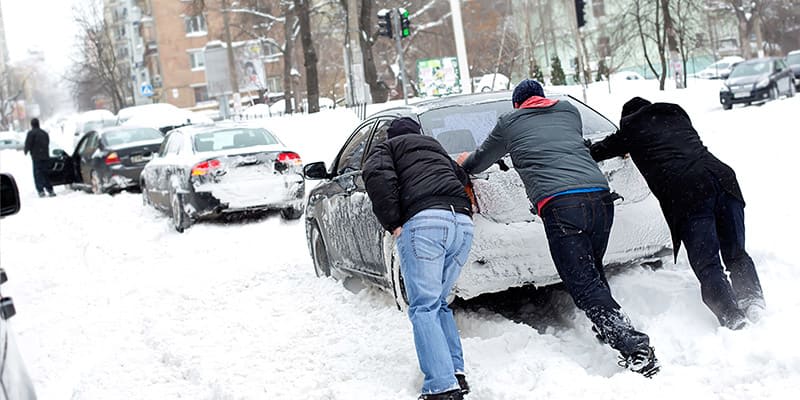
Key Findings
- Unequipped UK...4 out of 10 Brits don’t carry essential items needed in event of a breakdown
- All the gear, no idea…Half of all motorists are unaware of the correct gear to efficiently pull away in snowy conditions
- Rookies taking on the snow…700,000 newly qualified drivers from mid-2018 will face snow for the first time this year
- Snow creek without a shovel…just 16% of motorists store a shovel in their car, essential for safety when driving in snow
- Fuel for the fire…only one in four members of the public keeps extra fuel in their car during winter
- Get a grip… just 7% of motorists own snow tyres, the safest way to drive in snow
- Two thirds of UK motorists breaking the law…68% of motorists have illegally driven with snow on their car roof in the previous 12 months
UK motorists aren’t prepared for snowy conditions
Our study has revealed that nearly half of the British public do not currently store essential items in their vehicle that may prove vital in event of a breakdown. This is even more imperative when driving in snow and ice, as research has shown that vehicles are far more likely to experience difficulties in harsh driving conditions, as roads become more treacherous and drivers battle the elements. If your car does become immobile due to snow or ice, it’s important to have the correct equipment so that you’re able to fix any issue, wait for assistance and sustain yourself in the meantime.
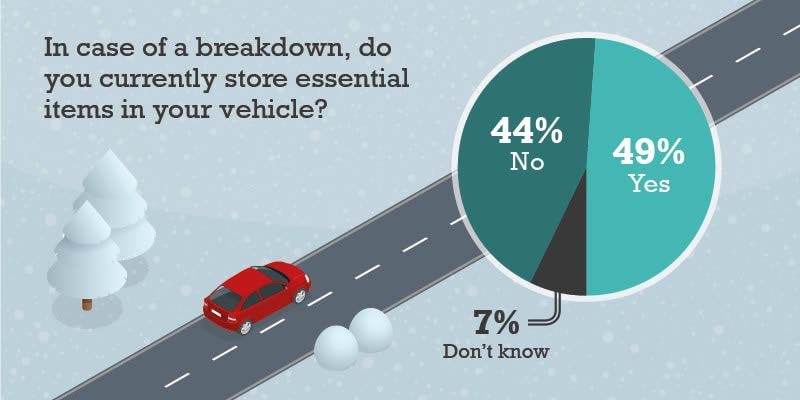
In general, motorists do tend to carry the bare essentials such as an ice scraper (69%) but other items that would be needed in an emergency are alarmingly missing from many of the public’s vehicles. Only one in three Brits currently carry jump leads and blankets, and less than one in five carry a shovel, needed to remove excess snow from around a vehicle in the eventuality of a breakdown.
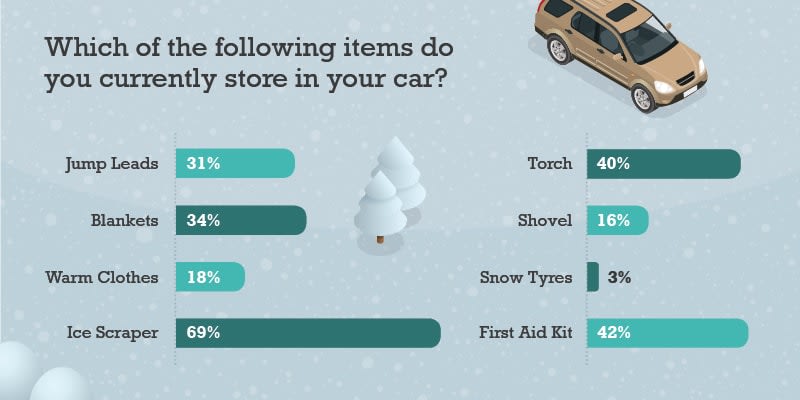
Fuelling the fire
It’s essential to carry extra fuel during winter, especially when driving in snow and ice. The cold air is thicker and denser than usual, leading to an increase in aerodynamic drag on your car. This means that your vehicle will burn more fuel, much faster. It also prevents you from running out of fuel and becoming stranded, which is especially challenging in low temperatures. Worryingly, only one in four motorists currently put this into practice.
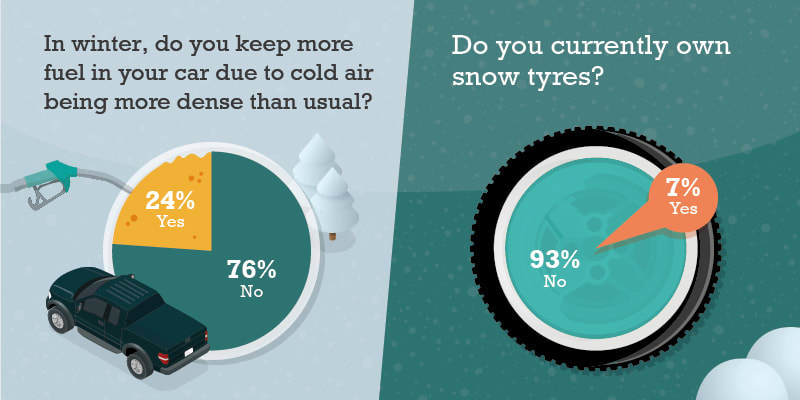
Just one in 14 UK motorists currently own snow tyres - a stark contrast to other Northern European countries such as Sweden, Norway and Denmark in which most of the population own and regularly use them. Basic snow tyres only cost around £30 each and can greatly improve your vehicle's grip on snowy roads. However, its clear many Brits are unable to grasp their value. But with colder and harsher conditions predicted for the next few months, is it time we got more realistic about preparing our vehicles in snow?
How should you tackle driving in snow?
If your car is not equipped with the correct tyres, the braking distance that your vehicle will require in order to stop while on snow or ice will greatly increase. As a general rule, hazardous driving conditions increase braking distances by a factor of 10. This is perhaps one of the most important aspects of driving safely during snowy spells and a clear indicator of how important taking extra care on the road can be when the weather turns. If you need to make an emergency stop and are driving too close to the car in front of you, the chances of a serious collision increase significantly.
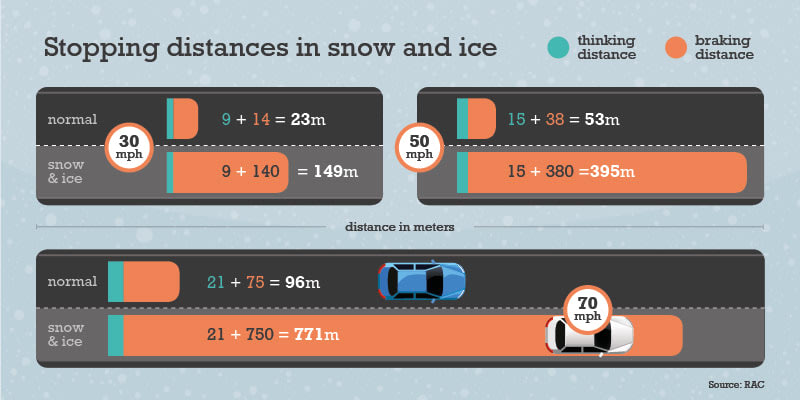
When the cold bites – how chilly temperatures may affect your car
During the winter months, your car may begin to suffer the effects of plummeting temperatures:
- During cold temperatures, your vehicle's tyre pressure will decrease due to the air contracting inside. This, in turn, increases the car’s rolling resistance.
- Your car battery may fail during cold periods, as icy weather will remove voltage from the battery, meaning you may have trouble starting your car.
- Due to your car not being able to hit the best operating temperature quick enough on cold days, fuel economy will be lowered during short journeys.
- Increasing friction between the moving parts of your engine may be caused by engine oil being thicker than usual due to the cold conditions.
- Your power steering, transmission and brake fluid may freeze, along with your antifreeze and windscreen wash.
How to prepare your car for snow
According to Insure the Box, motorists are 20% more likely to be in an accident during the winter months. A contributing factor to this may be that every year, 700,000 newly approved drivers will tackle snow for the first time. In order to stay safe when the snow hits, be sure to follow these important driving guidelines:
- Allow extra time for your journey so that you arrive at your destination promptly and aren’t tempted to drive faster than you should if you’re late.
- Check the essentials on your car including your windscreen wipers, tyre pressure, oil and screen wash are functioning properly.
- Be sure to prepare for the worst by storing a high-vis jacket, some food, warm clothing, phone charger, map and first aid kit.
- Be sure to accelerate gently to ensure you minimise the risk of wheel spin and your car skidding.
- When you’re approaching a corner on the road, brake before you enter the bend so that you don’t enter a corner too quickly and skid.
When you’re driving on snow or ice and come to a halt, moving off again in second gear will help to greatly reduce wheel spin. Nowadays, some cars have a “winter mode” which does this job for you. Our survey has shown that less than half of motorists know about this method, which is recommended by the RAC and other major insurers.
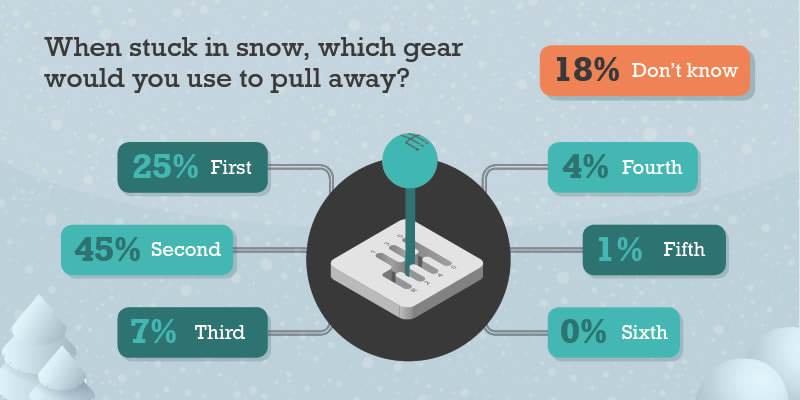
Stay on the right side of the law
During the winter months, the snow and ice can lead to an increase in journey times. Most of us have been rushing to work at one time or another and been faced with a car covered in snow or frost, that can only add time to the journey. Although this can be annoying, it’s important that you defrost all your vehicles windows, clear the snow off the roof and make sure that your number plate isn’t obscured.
According to a previous study of 1,200 motorists by Select Car Leasing, seven out of ten drivers have driven with snow on their roofs in the last 12 months, potentially leaving themselves open to a £60 fine, 3 penalty points and the reality of endangering the safety of themselves and other motorists. And that’s not the only infringement that could leave you in hot water! While failure to defrost your windscreen will only wind up a £60 penalty - an obscured number plate could land you a whopping £1,000 fine.
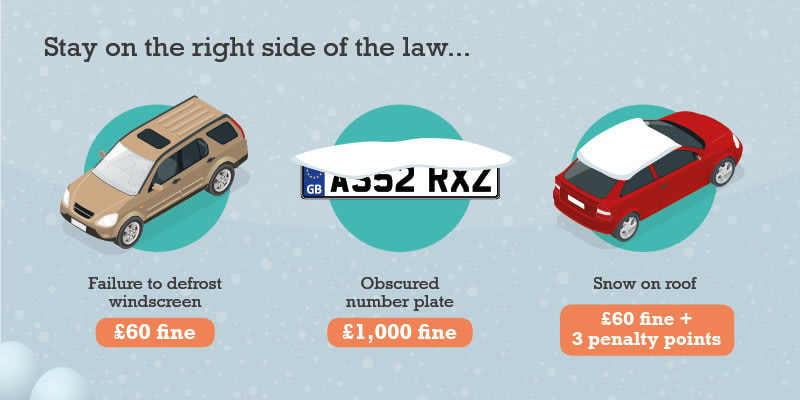
Are you ready for snow?
How much have you learned about tackling snow? Feeling confident? Take our winter driving quiz below to find out if you're really ready to face the next 'Beast from the East'.
















